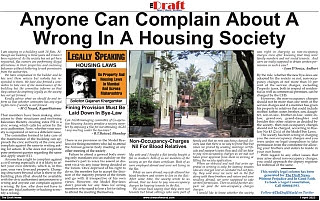The Unofficial ‘Surcharge’ That’s Killing Goa Tourism
By Gajanan Khergamker
In the sun-drenched state of Goa, where the sands of Arambol shimmer and the breeze promises relaxation, the price tags at local stores tell a different story—one of brazen overcharging and systematic intimidation. The modest MRP—Maximum Retail Price—printed on packaged goods is casually dismissed by shopkeepers near popular beach belts who impose a ‘tourism surcharge’ that is as unofficial as it is illegal. And those who dare to resist? They’re met not with apologies but a collective outcry from local vendors who gang up with a vehemence that borders on mob-like aggression.
Across the northern beaches of Goa—once considered paradisiacal retreats—wine shops and supermarkets are now the frontlines of fleecing. A bottle of beer, tagged at ₹100, is sold for ₹150, while mineral water—an essential for tourists—is hiked by ₹20 to ₹30 per bottle. Imported liquor, an erstwhile draw for tourists owing to Goa’s low taxes, is now steeply overpriced in these dens of daylight extortion. And any attempt by tourists to question the unethical practice is swiftly quelled by a chorus of local traders who join ranks in intimidation, often with the help of lurking touts and idle miscreants. This isn’t just an isolated phenomenon. It’s a pattern—chillingly regular and silently endorsed.
 |
| Supermarkets and wine shops along the road leading to Arambol Beach are known to bully, swindle and overcharge customers |
Arambol, once a haven for serene yoga retreats and holistic healing, has now become infamous not for its sunset drum circles but for the audacious price-gouging at its so-called “supermarkets.” And the matter doesn’t end at commerce. The menace extends into the realm of safety. Tourists—particularly domestic ones—who raise their voices are not just overcharged but threatened, their protests often silenced by the looming threat of violence. Social media is rife with testimonies of unsuspecting families being harassed, young travellers being manhandled, and women tourists being shouted down by cabals of overzealous locals defending the ‘right’ to extort.
But if overpricing in shops is rampant, what happens in North Goa’s smaller, local eateries—particularly those tucked away in Arambol and Querim—is far more insidious. Here, the concept of a menu card is either entirely missing or deliberately vague. If one does surface, it is often nothing more than a list of dishes—without any prices. Why? Because prices, quite literally, are at the whim of the Goan manning the kitchen or bar. Two guests at the same table—one a local and the other a tourist—will be billed wildly different amounts for the same fare. Locals, naturally, pay a fraction of what tourists are charged.
In these establishments, transparency is not just absent—it is actively avoided. A plate of fish curry rice may cost ₹150 for a local and ₹350 or more for a tourist, with not so much as a blush from the staff. The difference isn’t subtle, it’s systemic. And tourists, caught unaware, are regularly short-changed—figuratively and literally. Getting cheated at every turn has become the norm, not the exception, in this corner of Goa.
Take, for instance, the solitary restaurant-cum-bar at the scenic Tiracol jetty. It offers a fixed-price menu, yes—but only on paper. What arrives at the table is a thali with bowls so small they could fit in the palm of a child’s hand. The portions are laughably meagre, the quality questionable, and the charges sky-high. And all this, mind you, is non-negotiable. Ask for clarification or a breakdown of the bill, and one is met with either blank stares or hostile glares.
What began as an organic, low-cost haven for backpackers and spiritual seekers is rapidly degenerating into a profit-first, ethics-last free-for-all. The Goa Government’s silence on this dual-pricing debacle speaks volumes. The Department of Legal Metrology, tasked with regulating MRP violations, appears to play spectator, while tourism officials remain safely ensconced behind slogans and sanitised statistics. The Goa Police, understaffed and under-directed in such micro-issues, rarely intervenes unless pushed by viral videos or press exposure.
The larger implication, tragically, is a withering tourism industry. Tourists are no longer charmed by Goa’s free-spirited image. Instead, they return home with stories of being fleeced, threatened and disappointed. It comes as no surprise that footfall is dwindling, particularly of family tourists and solo women travellers who once populated the quieter beaches and boutique resorts of North Goa.
It is time the Goa Government takes stock of the rot festering at the retail and hospitality level—because the malaise isn’t confined to just alcohol or chips. It is reflective of a broader culture of impunity that threatens to erode Goa’s reputation.
Instead of relentlessly flogging North Goa’s beaches as the epicentre of tourism, policymakers must pivot towards more sustainable, value-driven tourism—religious and cultural tourism being key. Towns like Ponda, home to ancient temples and a heritage steeped in Goan Hindu traditions, are grossly under-promoted. The Sri Mangeshi Temple, the Shantadurga Temple, and the many sacred sites tucked into Goa’s hinterlands hold immense potential to attract discerning Indian tourists seeking cultural immersion and spiritual solace—not just nightlife and narcotics.
The insistence on projecting Goa as merely a party capital is not only outdated but self-destructive. The beach belts—once ideal for a languid escape—are increasingly associated with drunken brawls, open drug abuse, and unchecked lawlessness. Drunkards sleep off their stupor on beach shacks, mischief-mongers prowl the sands for their next victim, and peddlers operate in full public view—unafraid, unbothered.
Tourism cannot thrive in an environment where the rule of law is mocked in broad daylight and where consumers are treated as prey. If Goa hopes to preserve its legacy and reclaim its image, the time to act is now. Crack down on MRP violations. Penalise retail and restaurant thuggery. And pivot the spotlight towards Goa’s cultural heartland.
Because a tourist destination, no matter how scenic, is only as safe—and fair—as its marketplace.



